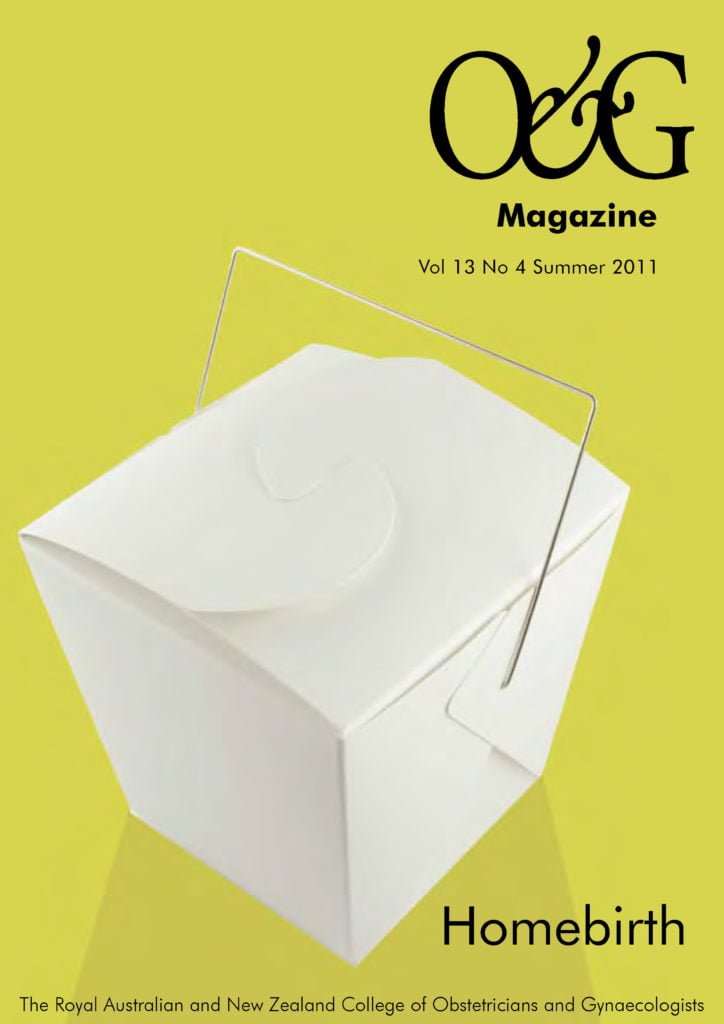Welcome to the Summer edition of O&G Magazine. This issue presents a diverse range of opinion on the contentious subject of homebirth. There is incongruity between the quantitative (the number of homebirths in Australia) and qualitative (the media exposure and public interest) aspects of the debate that surrounds homebirth. It is timely for the College to address the question with a series of articles from a diverse range of stakeholders, both health professionals and consumers. I expect this edition of O&G Magazine to generate further lively debate and I believe the articles speak eloquently both for and against birth in locations remote from the hospital environs.
College activity continues apace in the interval since the Spring edition of O&G Magazine, with the seventh RANZCOG Council and my tenure as President reaching the halfway mark with the November Council meeting. Reviewing the Strategic Plan for this two-year term shows excellent progress in achieving the goals and specific outcomes set out in September 2010 at the combined Executive/Board meeting of the sixth and seventh Councils.
Within the College and its membership, we are facing a crisis of participation. That’s not to say Fellows, Trainees and Diplomates are not paying their subscriptions or posting back the appropriate paperwork, but in terms of the viability of RANZCOG (and indeed any professional body, college or other), the ongoing pro bono contribution of the membership to the work of our College is absolutely critical to maintaining any sustainable position as a leader in training, education and re-certification in our specialty. In my role as President, I oversee the large and diverse range of projects, programs and processes that are the raison d’être for RANZCOG. Increasingly, Board members, Committee Chairs, senior College staff and I are asking the same small number of College stalwarts to step up and contribute. While, inevitably, good governance and the need for specific expertise will mean that significant proportions of the work will be concentrated among a small volunteer group who willingly take on that role, the need for a wider participation in less demanding (but equally important) roles is a pressing imperative.
The recent Regional Committee elections were an excellent, albeit disappointing, example of the problem. With the exception of New Zealand, where a very successful promotional exercise to sell the benefits of Regional Committee participation resulted in a contested election for positions, the Regional Committees either just made the quota with uncontested nominations or required a call for casual vacancies to be filled.
Those who have contributed many years of College work should be permitted to step back and develop other pursuits; indeed, a healthy organisation will have a steady recruitment from newer members, bringing contemporary ideas and fresh enthusiasm to the governing and administration of the committees and Council. Recruiting this ‘new blood’ into College participation has proved a difficult task for this and previous executives.
In a continued effort to add diversity and relevance to our CPD program, I am pleased to report that RANZCOG has signed a contract to bring Practical Obstetric Multi-Professional Training (PROMPT) to Australia and New Zealand. Recognised as an obstetric emergency training course that focuses specifically on teamwork rather than individual skills, the PROMPT license has been generously gifted to the College by Victorian Managed Insurance Authority (VMIA) and, after revisions to ‘Australianise’ the course content, will be introduced in New South Wales regional centres using Commonwealth Rural Health Continuing Education funding. Promoting training as a team with colleagues in midwifery, paediatrics and anaesthesia is evidence of RANZCOG’s commitment to collaborative care in maternity health care.
Within College House, and as part of maintaining engagement with relevant external agencies, we have two new committees. The first, mentioned briefly in the Spring edition of O&G Magazine, is the Workforce Committee, whose brief is to collate and respond to the various issues relating to medical workforce. Our online Practice Profile, which had a participation rate of nearly 70 per cent from the Fellowship, has provided valuable contemporary data to inform government and various agencies such as Health Workforce Australia about the current and projected requirements for a sustainable O and G workforce in both Australia and New Zealand. A similar Practice Profile for Diplomates is now active. The second is a new group that is charged with coordinating all the various aspects of diagnostic imaging that impact on both obstetric and gynaecological practice. With the expiry of the Memorandum of Understanding between the Department of Health and Ageing, the Royal Australian and New Zealand College of Radiologists and RANZCOG, there is a pressing need to monitor and respond to both the intrusion of regulation and also the training needs in this key area of daily practice in O and G. This group, while reporting to the Board and Council, is complementary, rather than in opposition, to ongoing work by the COGU subspecialty, the Australasian Society for Ultrasound in Medicine and, of course, the political voice of O and G, the National Association of Specialist Obstetricians and Gynaecologists.
Interacting with the international O and G community is part of the strategic plan to ensure RANZCOG has a voice in both our region and on the world stage. The Asia Oceania Federation of Obstetrics & Gynaecology (AOFOG), of which Australia, New Zealand and Papua New Guinea are members from our region, meets biennially to hold a Congress and deals with administrative matters through its Council. With the recent addition of Cambodia and China, to make the membership 26 countries in total, the organisation represents over four billion people. RANZCOG’s involvement has included co-hosting the 2009 AOFOG Congress with the 2009 ASM in Auckland and, recently, Dr Digby Ngan Kee (Vice-President, New Zealand) and I attended 2011 Congress in Taipei. RANZCOG will host the next Council meeting in Fiji in 2012, with the aim of highlighting the maternal and perinatal health needs of the Pacific region to members of AOFOG, as well as showcasing the cooperative work of the Pacific Society for Reproductive Health (PSRH) and RANZCOG. I believe in this, the ‘century of Asia’, we need to increase our contribution to both the expert working committees of this organisation and through participation rates in the next Congress, to be held in Thailand in 2013.
The International Federation of Gynecology and Obstetrics (FIGO), occupies centre stage in both world O and G medical politics and clinical leadership for addressing the not-insignificant health problems of the world’s women and newborns, particularly those in the developing nations, where the statistics on maternal and perinatal outcomes remain stubbornly alarming. The College’s official nomination and support of former RANZCOG President Dr Ken Clark as a candidate for FIGO President-elect, to be voted upon at the Rome Congress in October 2012, is an opportunity to place our College at the forefront of leadership and reform on the international stage. The Board has no hesitation in backing Dr Clark for this position of international medical leadership and I ask any Fellow who is able to promote the RANZCOG nomination at international meetings and through contacts in other O and G colleges to do so at every opportunity.
I wish to draw your attention to the new website, with www.ranzcog.edu.au now directing members to a much more user-friendly interface. New features include current news items, announcements, rapid access to college opinion pieces and responses to current issues, in addition to a platform that will soon provide a ‘one-stop shop’ link for Fellows, Trainees, Diplomates and other member categories to access online CPD, educational resources and audit tools. As with all things new, there will be some adjustments to the new layout and features, and feedback is welcomed to the senior IT Coordinator.
In November I attended a meeting in Perth to acknowledge new frontiers in gynaecological surgery (The Complicated Pelvis) and also pay tribute to Prof Ian Hammond’s outstanding contribution to our specialty, in particular, the science and teaching of pelvic surgery. As part of that meeting I was invited to address the topic: ‘Is the College relevant?’ Preparing that talk caused me to focus on the key factors in promoting RANZCOG as the standard bearer of our motto ‘Excellence in Women’s Health’. Despite my concerns expressed in the opening lines of this editorial, I remain very confident we can maintain and improve our position and influence in this important, but increasingly volatile, health environment.
Between editions of O&G Magazine the College lost two great members of our profession (see p80 for their obituaries). Profs Carl Wood and Tony McCartney can only be described as luminaries and great leaders in their chosen fields of reproductive medicine and gynaecological oncology. Countless thousands of women benefited both directly and indirectly from the contributions of these greatly admired and respected colleagues. RANZCOG extends its sympathies and thoughts to their families, friends and colleagues.
Over the last three months the CEO of RANZCOG, Dr Peter White, has been taking a well-earned break on long-service leave, with his position filled by the Acting CEO Valerie Jenkins. On behalf of the Board and staff of College House, I thank Valerie for the magnificent job she has done in Peter’s absence and also welcome Peter back to work on 14 November.
My best wishes and season’s greetings to RANZCOG members, College staff and all those involved in our collegiate endeavours.





Leave a Reply